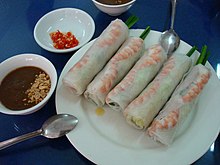Tương
This article includes a improve this article by introducing more precise citations. (March 2013) ) |
Fermented soybeans , salt |

Tương (Vietnamese: Vietnamese cuisine.
Originally, the term tương refers to a
summer rolls (gỏi cuốn). The paste, which is generally dark brown in color, is produced by adding the fungus Aspergillus oryzae to roasted soybeans, which are then allowed to naturally ferment in a jar with water until it develops an umami flavor. Other ingredients, such as glutinous rice or maize powder, salt, or water, may also be used. Tương is similar to the Chinese yellow soybean paste
, though the latter is generally saltier and thicker in texture.
Tương may range in consistency from a thick paste to a thin liquid. Some varieties, such as that prepared in Central Vietnam, are watery, with solids at the bottom of the container in which it is stored. A more condensed variety, called tương Bần or tương làng Bần, is produced in the town of Bần Yên Nhân, in Mỹ Hào district of
Hà Tây Province
) and tương chùa Mía (Đường Lâm village, Hà Tây Province). In Southern Vietnam, it is called tương hột.
Tương is commercially available in glass and plastic jars and bottles throughout Vietnam, as well as in Vietnamese grocery stores overseas.
The word tương can also be used to refer to other condiments, such as tương cà (
chilli sauce). In southern Vietnam, nước tương refers to soy sauce
while Northern Vietnam calls it xì dầu.
Varieties
Tương đen (or tương ngọt, or Hoisin sauce)
- Phở
- Gỏi cuốn: a variation of tương đen is used. This variation is called tương xào.
- Bò bía: uses tương xào.
- Chạo tôm: a variation of tương đen is used. This variation is called tương kho.
- Nem nướng: uses tương kho.
- Bánh ướt thịt nướng: uses tương kho.
- Cuốn tôm chua: a variation of tương đen is used. This variation is called tương ruốc.
Tương ớt
Sauce with chilli and garlic.
- Sriracha sauce
Tương Bần and tương Cự Đà
Tương Nam Đàn
- Bánh khoái, a pancake which is similar to bánh xèo.
Etymology
The word tương derives from the Chinese word jiàng (Chữ Hán: 醬), meaning "paste."
See also
- Cuisine of Vietnam
- Fermented bean paste
- List of fermented soy products

